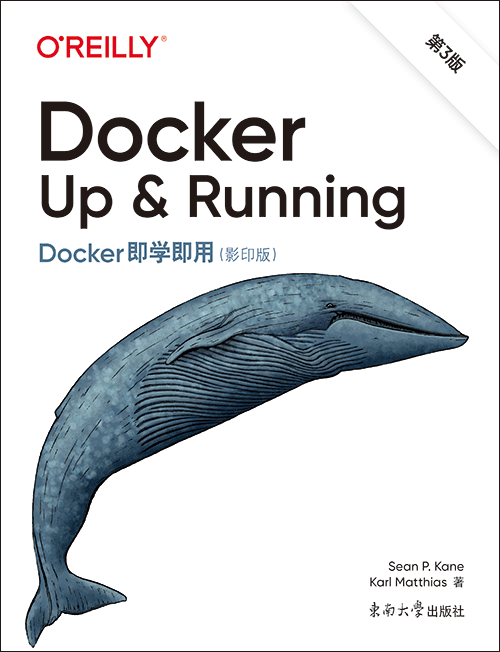Docker即学即用 第3版(影印版)
出版时间:2024年03月
页数:416
“本书带你度过Docker蜜月期,为你在生产环境中运行容器的现实做好准备。”
——Kelsey Hightower
Google Cloud Platform首席开发者推广大使
“本书涵盖了基本的底层概念以及从大规模运行Docker中获得的宝贵实践经验。”
——Liz Rice
Isovalent首席开源官与eBPF专家
“本书将指导你构建现代、可靠、高可用的分布式系统。”
——Mihai Todor
TLCP高级首席工程师
Docker和Linux容器从根本上改变了组织大规模开发、交付、运行软件的方式。然而,理解为什么这些工具如此重要以及如何成功地将其整合到组织生态系统中可能并非易事。这本全面更新的指南可以帮助开发人员、运维人员、架构师、技术经理深入了解Docker工具集以及容器如何改善现代软件交付和管理的几乎每个方面。
新版的更新反映了Docker自近十年前首次发布以来发生的重大变化。Sean Kane和Karl Matthias对全书做了修订,体现了现今的最佳实践,并加入了BuildKit、多架构镜像支持、无根容器等诸多内容。
● 了解Docker和Linux容器如何与云服务和Kubernetes集成
● 使用强大的命令行工具构建Open Container Initiative(OCI)镜像以及部署和管理Linux容器
● 了解OCI镜像如何为应用程序简化依赖项管理和部署工作流
● 学习在生产环境中部署和测试Linux容器的实践技术
● 在任何需要的地方大规模部署生产容器
● 探索包括部署工具、网络、编排、安全和配置在内的Docker高级主题
——Kelsey Hightower
Google Cloud Platform首席开发者推广大使
“本书涵盖了基本的底层概念以及从大规模运行Docker中获得的宝贵实践经验。”
——Liz Rice
Isovalent首席开源官与eBPF专家
“本书将指导你构建现代、可靠、高可用的分布式系统。”
——Mihai Todor
TLCP高级首席工程师
Docker和Linux容器从根本上改变了组织大规模开发、交付、运行软件的方式。然而,理解为什么这些工具如此重要以及如何成功地将其整合到组织生态系统中可能并非易事。这本全面更新的指南可以帮助开发人员、运维人员、架构师、技术经理深入了解Docker工具集以及容器如何改善现代软件交付和管理的几乎每个方面。
新版的更新反映了Docker自近十年前首次发布以来发生的重大变化。Sean Kane和Karl Matthias对全书做了修订,体现了现今的最佳实践,并加入了BuildKit、多架构镜像支持、无根容器等诸多内容。
● 了解Docker和Linux容器如何与云服务和Kubernetes集成
● 使用强大的命令行工具构建Open Container Initiative(OCI)镜像以及部署和管理Linux容器
● 了解OCI镜像如何为应用程序简化依赖项管理和部署工作流
● 学习在生产环境中部署和测试Linux容器的实践技术
● 在任何需要的地方大规模部署生产容器
● 探索包括部署工具、网络、编排、安全和配置在内的Docker高级主题
- Foreword
- Preface
- 1. Introduction
- The Promise of Docker
- What Docker Isn’t
- Important Terminology
- Wrap-Up
- 2. The Docker Landscape
- Process Simplification
- Broad Support and Adoption
- Architecture
- Getting the Most from Docker
- The Docker Workflow
- Wrap-Up
- 3. Installing Docker
- Docker Client
- Testing the Setup
- Exploring the Docker Server
- Wrap-Up
- 4. Working with Docker Images
- Anatomy of a Dockerfile
- Building an Image
- Running Your Image
- Custom Base Images
- Storing Images
- Optimizing Images
- Troubleshooting Broken Builds
- Multiarchitecture Builds
- Wrap-Up
- 5. Working with Containers
- What Are Containers?
- Creating a Container
- Starting a Container
- Auto-Restarting a Container
- Stopping a Container
- Killing a Container
- Pausing and Unpausing a Container
- Cleaning Up Containers and Images
- Windows Containers
- Wrap-Up
- 6. Exploring Docker
- Printing the Docker Version
- Server Information
- Downloading Image Updates
- Inspecting a Container
- Exploring the Shell
- Returning a Result
- Getting Inside a Running Container
- Logging
- Monitoring Docker
- Prometheus Monitoring
- Exploration
- Wrap-Up
- 7. Debugging Containers
- Process Output
- Process Inspection
- Controlling Processes
- Network Inspection
- Image History
- Inspecting a Container
- Filesystem Inspection
- Wrap-Up
- 8. Exploring Docker Compose
- Configuring Docker Compose
- Launching Services
- Exploring Rocket.Chat
- Exercising Docker Compose
- Managing Configuration
- Wrap-Up
- 9. The Path to Production Containers
- Getting to Production
- Docker’s Role in Production Environments
- Docker and the DevOps Pipeline
- Wrap-Up
- 10. Containers at Scale
- Docker Swarm Mode
- Kubernetes
- Amazon ECS and Fargate
- Wrap-Up
- 11. Advanced Topics
- Containers in Detail
- Security
- Advanced Configuration
- Storage
- nsenter
- The Structure of Docker
- Swapping Runtimes
- Wrap-Up
- 12. The Expanding Landscape
- Client Tools
- All-in-One Developer Tools
- Wrap-Up
- 13. Container Platform Design
- The Twelve-Factor App
- The Reactive Manifesto
- Wrap-Up
- 14. Conclusion
- The Road Ahead
- The Challenges Docker Addresses
- The Docker Workflow
- Minimizing Deployment Artifacts
- Optimizing Storage and Retrieval
- The Payoff
- The Final Word
- Index
书名:Docker即学即用 第3版(影印版)
作者:Sean P. Kane, Karl Matthias 著
国内出版社:东南大学出版社
出版时间:2024年03月
页数:416
书号:978-7-5766-1199-1
原版书书名:Docker: Up & Running, 3rd Edition
原版书出版商:O'Reilly Media
Blue whales can grow up to 100 feet in length and 200 tons in weight, making them the largest animals on Earth, and the largest animals to ever exist. At birth, a blue whale calf is as large as an adult hippopotamus and can gain up to 200 pounds a day. When fully grown, blue whales are long and thin, with a small dorsal fin, two flippers at their side, and a horizontal tail, also known as a “fluke.” Blue whales are named for their bluish-gray coloring.
Blue whales are migratory and can be found in every ocean. They generally feed in colder polar regions and then head to warmer tropical waters to give birth. Blue whales usually travel alone or in pairs and communicate through a series of complex vocalizations. As a member of the rorqual (balaenopteridae) family, blue whales feed by straining their prey through bony plates in their mouths known as baleen. Their diet consists almost entirely of krill, a small crustacean similar to shrimp. They require 1.5 million kilocalories of energy every day and can eat up to 7,900 pounds of krill daily. Because of their speed and size, blue whales have practically no natural predators.
Blue whales were once widespread, with a population estimated in the hundreds of thousands. While they were initially too large and fast for whalers to capture, the invention of the harpoon gun in the late 1800s enabled whalers to successfully hunt blue whales. Decades of whaling followed, causing a significant population decline. An international ban on the hunting of blue whales was enacted in 1966, allowing their numbers to recover, although they remain endangered.
Blue whales are migratory and can be found in every ocean. They generally feed in colder polar regions and then head to warmer tropical waters to give birth. Blue whales usually travel alone or in pairs and communicate through a series of complex vocalizations. As a member of the rorqual (balaenopteridae) family, blue whales feed by straining their prey through bony plates in their mouths known as baleen. Their diet consists almost entirely of krill, a small crustacean similar to shrimp. They require 1.5 million kilocalories of energy every day and can eat up to 7,900 pounds of krill daily. Because of their speed and size, blue whales have practically no natural predators.
Blue whales were once widespread, with a population estimated in the hundreds of thousands. While they were initially too large and fast for whalers to capture, the invention of the harpoon gun in the late 1800s enabled whalers to successfully hunt blue whales. Decades of whaling followed, causing a significant population decline. An international ban on the hunting of blue whales was enacted in 1966, allowing their numbers to recover, although they remain endangered.
购买选项
